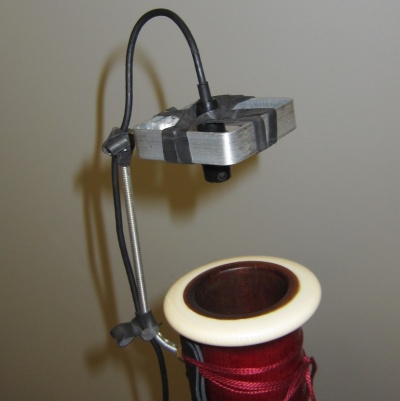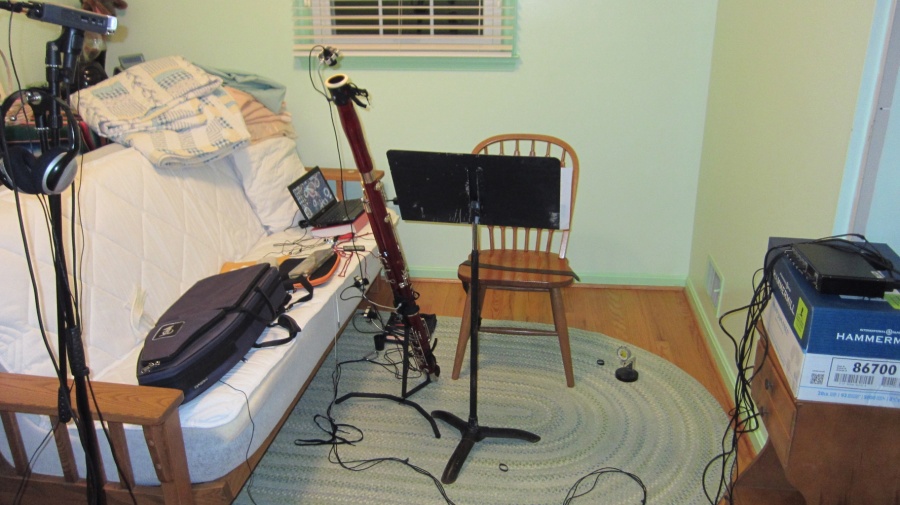Mic'ing a bassoon is a tricky proposition. In an ensemble, usually it's good enough to just get it with the area mics, or give the section an overhead. As a solo instrument, a standard set of hall mics on a small stage will do a good job, but for something up close, you usually have to result to multiple large diaphragm condensers, which is unwieldy and somewhat tricky to setup. Since the tone holes are so far apart and the bell is really only a primary sounding hole for low notes, you need more than one mic to cover the range evenly - unlike a trumpet where you can just mic the bell. There are bocal pickups which get the sound right near the reed, but they have two problems - you have to solder it in place (changing your bocal or requiring a new one), and that it picks up a coarse version of the sound - all the right frequencies, but without the dampening and mellowing that the body of the instrument provide.
In the summer of 2013 I decided to make a mic array - three separate microphones - to properly mic a bassoon's acoustic sound. I wanted them to be physically attached to the instrument, so that there's no impact on the sound if the player moves around, I wanted them to be out of the way so that there's no interference with technique, and I wanted them to be light, so that there's minimal impact on instrument balance and so that you can use the setup while standing in performance. I bought 3 Audio Technica AT853Rx mics (a generation old to save on cost), a Shure SCM268 to mix the mics into a single output channel, some aluminum wire, some leather pieces, and cut up rings from a bicycle inner tube and cobbled together a prototype. The wire was rigid enough to make it work, the leather protected the instrument from the metal, and the inner tube rings doubled as wire ties and shock mounts, but the prototype couldn't be reinstalled easily and went out of alignment quickly because it was so flimsy. It's one saving grace is that it sounded fairly good.
 Fast forward a couple of months to November, where a recording project had come up which seemed like a prime candidate for this setup and suddenly my interest was renewed. I scoured the internet and local hardware and craft stores for ideas for what to build it out of, and I came up with a pretty straight forward plan: square aluminum brackets used in signage for the bases, threaded aluminum rod for the arms, bent strip aluminum for the mic mounts and leather to cover everything that could contact the instrument. After gathering the materials, a second, more permanent, prototype was made and fastened to the instrument with embroidery thread (because it needed to fit under keywork and needed to be strong). It was still difficult to mount, but it was sturdy.
Fast forward a couple of months to November, where a recording project had come up which seemed like a prime candidate for this setup and suddenly my interest was renewed. I scoured the internet and local hardware and craft stores for ideas for what to build it out of, and I came up with a pretty straight forward plan: square aluminum brackets used in signage for the bases, threaded aluminum rod for the arms, bent strip aluminum for the mic mounts and leather to cover everything that could contact the instrument. After gathering the materials, a second, more permanent, prototype was made and fastened to the instrument with embroidery thread (because it needed to fit under keywork and needed to be strong). It was still difficult to mount, but it was sturdy.
Next came the sound testing and a long list of small adjustments. I switched to flat shoe laces to make installation quicker, I added wind screens to combat potential problems and give the mics a bit looser of a mount, and I recorded and listened back to adjust levels and placement. I realized when beginning to record the piece, that I had a lot of extraneous key noise, not the familiar clicks, but a low thud sound from the keys impacting the wood of the instrument. This was difficult to isolate, but by further loosening the shock mounts, slackening the mic cables, and removing a cable attachment point on the bottom of the boot I reduced it considerably. There's still some noise of this kind and still room left for improvement in this design, but with a high pass filter with a sharp cutoff (75 Hz with 48dB rolloff) almost all of the noise is removed with minimal loss in tone richness. It's not an ideal solution - the bottom note of the instrument sits just above 58Hz - but in practical application, it sounds fairly good.




